In this chapter, soft magnetic properties of three different injection-molded materials will be introduced. Soft magnetic materials are used for electromagnetic applications such as motors, transformers, sensors, and so on, because of their high magnetic induction with small magnetic field. Recently, these parts have been required to be small in size, with high output and high efficiency. In order to realize these properties, soft magnetic materials need to have iron loss minimized at high frequencies. Therefore, in this chapter, three types of ferromagnetic materials which are the most attractive materials for ferromagnetic industrial applications will be discussed as follows.
The first type is Fe-6.5Si. This alloy has excellent soft magnetic properties; however, Fe-6.5Si alloy has become well known as a brittle material, so it provides poor deformation properties. Powder metallurgy is an effective way to produce complexshaped parts, and also decreases the eddy current loss at high frequency by subdividing the eddy current area into small grains. However, it is difficult to obtain high density by conventional die-press molding of the powder. It is hoped that metal powder injection molding (MIM) could be a suitable processing technique for parts with complicated shapes, even when using hard and brittle materials. The magnetic properties of MIM compacts are expected to be better than those of conventional die-press sintered compacts, owing to the high densities achievable via MIM. In the first section, the various magnetic properties of MIM parts of Fe-6.5Si will be discussed as a function of the type of powders, processing techniques, and so on.
The second type is Fe-9.5Si-5.5Al. Fe-Ni and Fe-Si alloys are well known as soft magnetic materials. Specifically, Fe-9.5Si-5.5Al alloy is called a Sendust, and is suited for a magnetic head for a video tape recorder because of its high permeability and high magnetic flux density, as well as high-wear resistance. However, the applications of this alloy have been limited due to its poor workability. In the second section, the production feasibility of Fe-9.5Si-5.5Al alloys will be discussed, by MIM process, and also the soft magnetic properties of injection-molded compacts. In particular, the effects of different types of powder, grain size, and impurities (such as carbon and oxygen) on the magnetic properties are investigated in detail to obtain high-performance magnetic properties by changing the process conditions; also, some factors affecting the properties will be discussed, taking the microstructures into account.
Table 21.1 The characteristics of Fe-6.5Si
Powder | WH | Gm | Gl |
Routes | Water-atomized powder | Gas-atomized powder | Gas-atomized powder |
Carbon (mass%) | 0.006 | 0.005 | 0.006 |
Mean particle size (μm) | 0.31 | 0.09 | 0.004 |
Particle photo |
|
|
|
The third type is Fe-50Ni. For the MIM process of Fe-50Ni (permalloy), mixed elemental powder and prealloyed powder were used as the raw materials. In the case of the mixed elemental powder, obtaining high relative density is difficult because sintering is progressed in the area of austenite, for which the diffusion rate is low. On the other hand, high relative density can be expected with prealloyed powder because sintering is progressed in the area of ferrite. Also, the microstructure of prealloyed powder compacts appears to be more homogeneous than that of mixed elemental powder compacts. Therefore, in the final section of this chapter, the effect of mixed elemental and prealloyed powders on the magnetic properties of injectionmolded permalloys will be discussed.
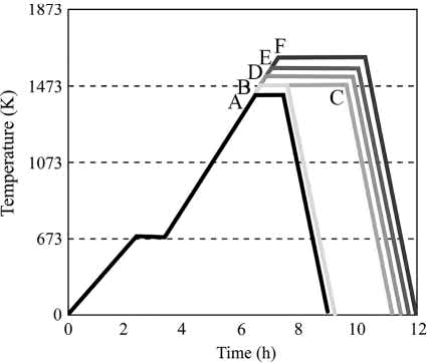
Fig. 21.1 Debinding and sintering programs
Table 21.2 Sintering conditions
Pattern | Temperature (K) | Time (h) |
A B C D E F | 1423 1473 1473 1523 1573 1623 | 1 1 3 3 3 3 |
In order to investigate the magnetic properties, toroidally shaped compacts were produced by injection molding. The cavity size was 45mm outer diameter, 30mm internal diameter and 5.6mm thick. Green compacts were debound at 348 K for 18 ks in an n-heptane atmosphere and this was followed by thermal debinding in a hydrogen atmosphere. Sintering was performed at 1423-1623 K for 1-3 h using electric furnaces in a hydrogen atmosphere. Fig. 21.1 shows the heat pattern of thermal debinding and sintering steps, and Table 21.2 lists the sintering conditions. No secondary heat treatment was carried out.
Density measurement by Archimedes method, hardness testing (HRa), optical observation, elemental analysis for carbon and oxygen, and magnetic characterization were performed for each sintered compact.
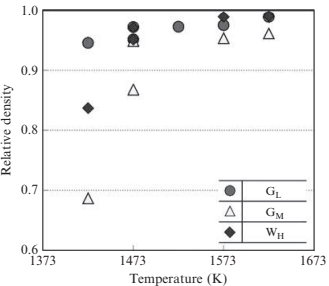
Fig. 21.2 Relationship between relative density and sintered temperature
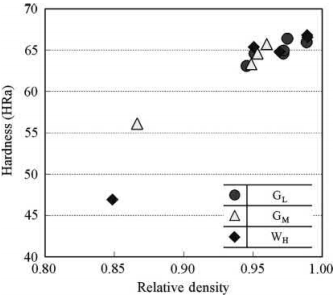
Fig. 21.3 Changes of hardness with respect to relative density
The relationship between relative density and sintered temperature is shown in Fig. 21.2. The sintered densities of all compacts increase with increasing sintered temperature. In particular, the sintered density of GL appears higher than the others, even at lower sintering temperatures. The relationship between hardness and relative density is shown in Fig. 21.3. The hardness also increases with increasing relative density.
Fig. 21.4 shows the optical micrographs of non-etched and etched cross-sections of the compacts sintered at 1623 K for 3 h. The relationship between the mean grain size and relative density is shown in Fig. 21.5. The grain size of GL appears to be about ten times larger than the other compacts. This is thought to be because the middle stage of sintering (high densification) ends within a short time and the later stage of sintering (grain growth) begins because the oxygen level of the powder is low.
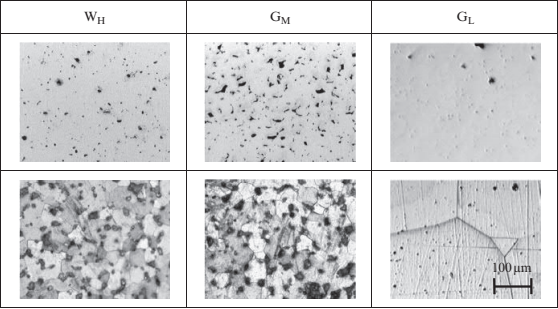
Fig. 21.4 Optical micrographs of compacts sintered at 1623 K for 3h
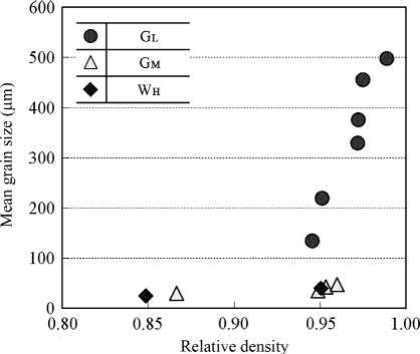
Fig. 21.5 Relationship between mean grain size and relative density
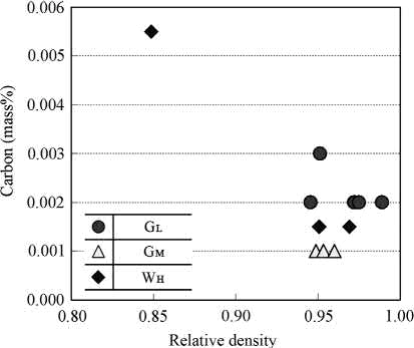
Fig. 21.6 Relationship between carbon content and relative density
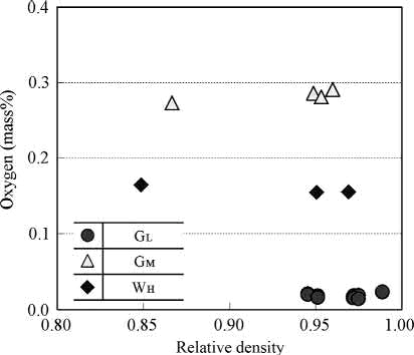
Fig. 21.7 Relationship between oxygen content and relative density
The relationship between the carbon content of sintered compacts and the relative density is shown in Fig. 21.6, and the relationship between the oxygen content and the relative density is shown in Fig. 21.7. In both cases, carbon and oxygen contents are not affected by relative density. Carbon contents of higher density compacts appear much lower than that of raw powders, as shown in Table 21.1. Oxygen contents of WH and GL are also decreased from their raw powders, but that of GM is increased and causes the lower density. Normally, the magnetic properties are mostly influenced by impurities, so that the high purity of GL is expected to show high magnetic performance.
Excellent soft magnetic material shows high magnetic induction (B) (Lall, 1992), high maximum permeability (μm), low coercive force (HC), and low core loss (WB/F). Magnetic properties for wrought material of Fe-6.5%Si are compared to those of sintered compacts.
The relationship between magnetic induction (B100) and relative density is shown in Fig. 21.8. In all compacts, the magnetic inductions are increased in proportion to their relative densities. Moreover, the compacts with higher density show high magnetic induction, equivalent to the value of wrought material. The relationship between maximum permeability (μm) and relative density is shown in Fig. 21.9. The maximum permeability increased with increasing relative density. The relationship between coercive forces (HC) and relative density is shown in Fig. 21.10. The coercive forces are decreased with increasing relative density, and GL shows a lower value than the others. These results indicate that the sintered compacts with high density and high purity show good magnetic properties.
Figs. 21.11 and 21.12 show the hysteresis loss (Kh) and eddy-current loss (Ke) as a function of relative density. There is no apparent strong relation between either of these losses (Kh and Ke) and density, but the eddy-current loss of WH is lower than the others. Fig. 21.13 shows the iron loss (WB/F) at various frequencies for three types of specimens, for which the relative densities are around 0.97. Although the iron losses at lower frequency are almost the same, there are large differences at higher frequency. The iron loss of WH shows the smallest value, which is considered to be because the effect of eddy current loss on the iron loss is large. In this case, not only the purity, but also the mean grain size seems to have an effect on the magnetic properties. Therefore, the improvement of density and the control of grain growth are necessary to obtain excellent magnetic properties.

Fig. 21.8 Relationship between magnetic induction and relative density
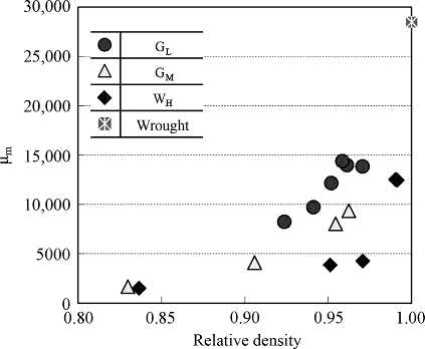
Fig. 21.9 The influence of relative density on maximum permeability
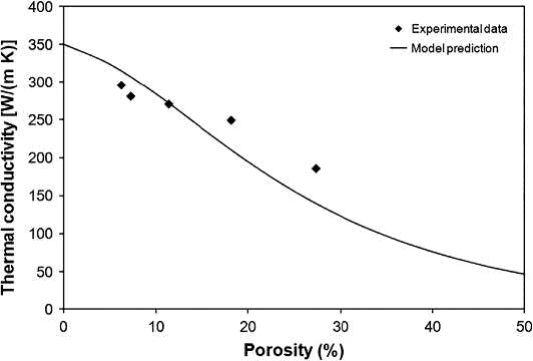
Fig. 21.10 Changes in coercive force with respect to relative density
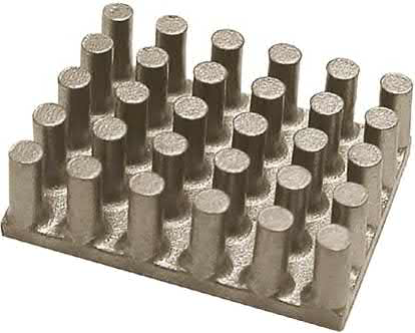
Fig. 21.11 Hysteresis loss in each specimen
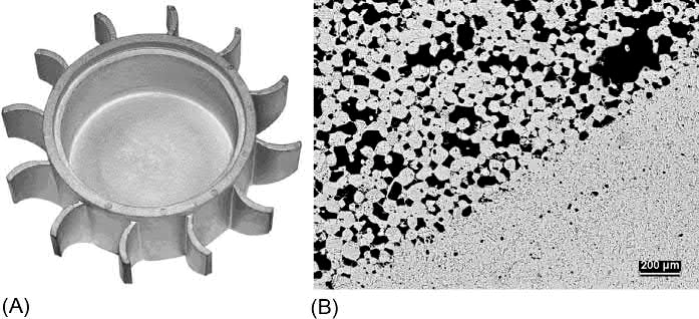
Fig. 21.12 Eddy-current loss in each specimen
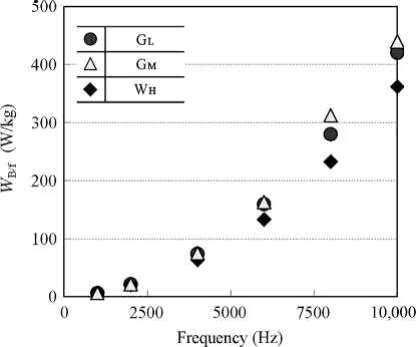
Fig. 21.13 Iron loss of selected specimens at various frequencies
Table 21.3 Chemical compositions of Fe-9.5Si-5.5A1
Si | AI | Mn | P | S | C | N | O | Fe | |
Gas-atomized powder (mass%) | 9.5 | 6.1 | - | - | 0.001 | 0.02 | 0.002 | 0.09 | Bal. |
Water-atomized powder (mass%) | 9.2 | 5.3 | 0.3 | 0.05 | 0.01 | 0.07 | - | 0.26 | Bal. |
The gas-atomized powder (mean particle size: 12.7μm) was used for the investigation. The chemical compositions of the powders are shown in Table 21.3. The powders were first admixed with wax-based multicomponent binders (paraffin wax (69%), polypropylene (20%), Carnauba wax (10%), and stearic acid (1%)) at 423 K for 3.6 ks. After injection molding, extraction debinding in condensed solvent, which was conducted at 348 K for 18 ks in n-heptane, was used to partially remove the wax components. Following this treatment, final thermal debinding was performed at 1103 K in hydrogen. Sintering was performed at 1473-1543 K for 3.6 ks in hydrogen or a vacuum. Sintered compacts were machined to the toroidal shape of 9mm outside diameter, 6mm inside diameter and 3mm thick, and the compacts were annealed at 1173 K for 21.6 ks in a vacuum to eliminate the residual stresses. The maximum magnetic flux density (B10), residual magnetic flux density (Br) and coercive force (Hc) were measured by a B-H loop tracer. The microstructures were also examined by photomicroscopy.
Fig. 21.14 shows the effect of sintering atmosphere and temperature on the relative density of injection-molded Sendust alloy compacts using gas-atomized powder. Although there is a little difference between the compacts sintered at low temperatures in hydrogen and in a vacuum, both densities reach 98% of theoretical at over 1523 K.
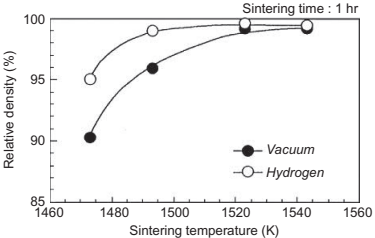
Fig. 21.14 Effect of sintering temperature and atmosphere on the density of MIM Sendust alloy compacts using gas-atomized powder
Fig. 21.15 shows the microstructures of the compacts sintered at various temperatures in a vacuum and in hydrogen. Both compacts sintered at 1473 and 1493 K show many pores. On the other hand, the compact sintered at 1523 K shows relatively high densification and still retains a small grain size. The compact sintered at 1543 K shows clearly the grain growth due to the liquid phase sintering, and the compact showed some distortion. Therefore, optimum sintering temperature for the injection-molded compacts seemed to be 1523 K.
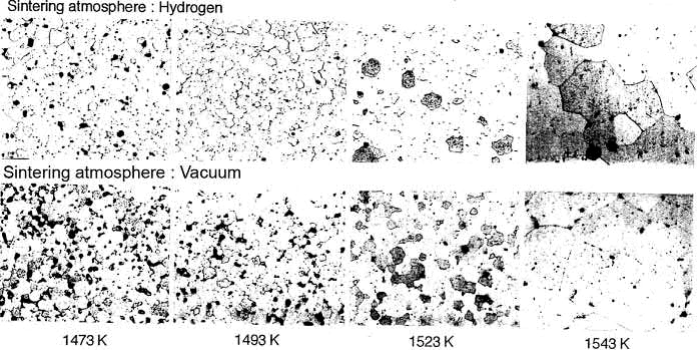
Fig. 21.15 Microstructures of the MIM Sendust alloy compacts sintered at various temperatures in a vacuum and in hydrogen
The magnetic properties such as maximum magnetic flux density (B10), residual magnetic flux density (Br), and coercive force (Hc) of the compacts sintered at various temperatures in a vacuum and in hydrogen are shown in Fig. 21.16. Normally, high B10, Br and Hc are suitable for soft magnetic materials. In Fig. 21.16, B10 values are little changed, but Br and Hc decrease with increasing sintering temperature. Decreasing the Br and Hc is a favorable tendency, but the values were relatively inferior to those of wrought materials.
Generally, the magnetic properties are strongly influenced by the grain size and impurities such as carbon and oxygen. Fig. 21.17 shows the grain size of compacts sintered at various temperatures. The grain sizes are little changed except in the liquid phase sintered compacts (at 1547 K). Most are similar to the original powder particle size. On the other hand, carbon content decreased dramatically from 0.02 mass% to 0.003 mass%, but oxygen content increased significantly from 0.09 mass% to 0.27 mass% after sintering. From these results, a small grain size and large amount of retained oxides seem to prevent the domain wall migration, resulting in insufficient magnetic properties for soft magnetic materials.
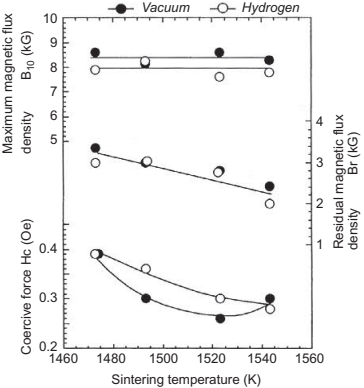
Fig. 21.16 Effect of sintering temperature and atmosphere on the magnetic properties of MIM Sendust alloy compacts using gas-atomized powder
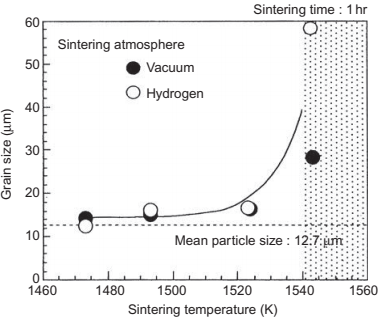
Fig. 21.17 Effects of sintering temperature and atmosphere on the grain size of MIM Sendust alloy compacts
In order to avoid the oxidation during debinding and sintering, a continuous process combining the debinding and sintering steps was performed, with the heating conditions as shown in Fig. 21.18. Fig. 21.19 shows the magnetic properties of the compacts sintered by conventional and continuous processes. B10 values are little changed even by changing the process. However, Br and Hc are significantly decreased by the continuous process. In particular, the effectiveness of the continuous process seems to appear at low sintering temperature.
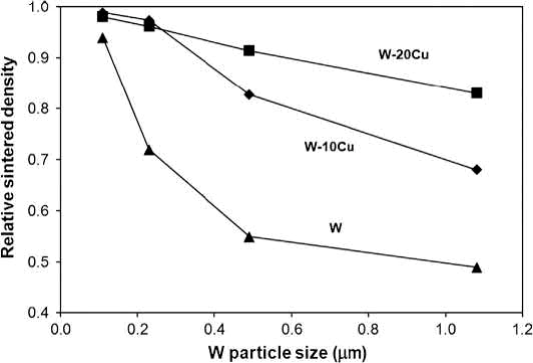
Fig. 21.18 Heating conditions for (A) Conventional. (B) Continuous processes
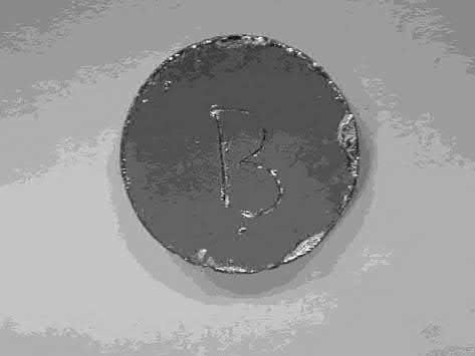
Fig. 21.19 Effect of continuous process on the magnetic properties of MIM Sendust alloy compacts using gas-atomized powder
Fig. 21.20 shows the relative densities of sintered compacts by both conventional and continuous processes. Obviously high densification occurs at low sintering temperature in the case of the continuous process. Fig. 21.21 shows the microstructures of the compacts sintered by conventional and continuous processes. As would be expected, for the continuous process, there is significant grain growth at lower temperature in a vacuum and at a similar temperature in hydrogen. However, for the conventional process the grain sizes are little changed, even by increasing the temperature.
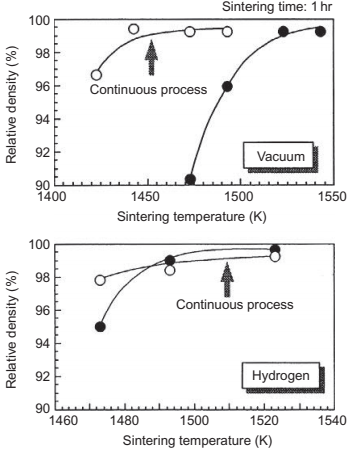
Fig. 21.20 Effects of process conditions on the density of MIM Sendust alloy compacts
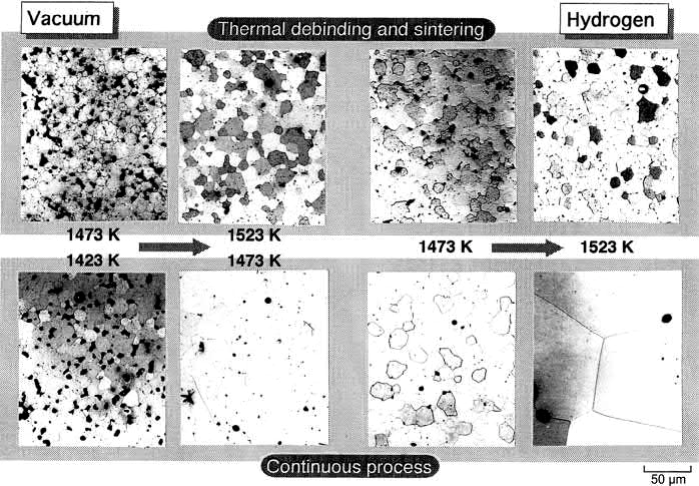
Fig. 21.21 Microstructures of MIM Sendust alloy compacts produced by different processes
For the continuous process, low oxygen content and large grain size are obtained, as shown in Fig. 21.22. This contributes to the improvement of soft magnetic properties of injection-molded Sendust alloys.
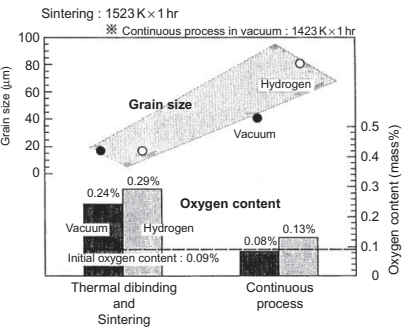
Fig. 21.22 Grain size and oxygen content of MIM Sendust alloy compacts produced by different processes
Fig. 21.23 shows the effect of sintering temperature on the density, hardness, and carbon content of injection-molded compacts using water- and gas-atomized powders. Density and hardness are increased with an increase in temperature, and there is little difference between the compacts. On the other hand, magnetic properties of waterand gas-atomized powder compacts sintered at various temperatures are shown in Fig. 21.24. There is little change in B10. However, Br and Hc are very different between the powder compacts. The water-atomized powder compact shows relatively poor magnetic properties.

Fig. 21.23 Effects of sintering temperature on the density, hardness and carbon content of MIM Sendust alloy compacts using gas- and water-atomized powders
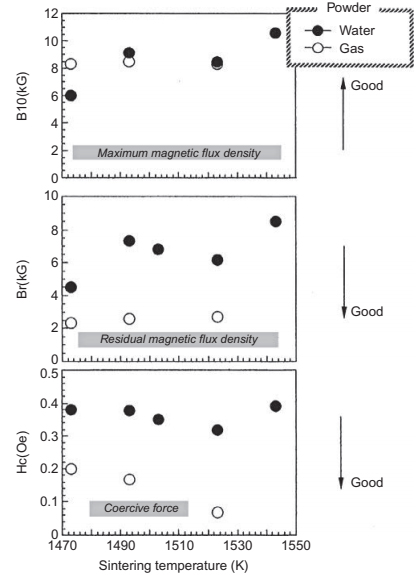
Fig. 21.24 Effects of sintering temperature on the magnetic properties of MIM Sendust alloy compacts using gas- and water-atomized powder
Fig. 21.25 shows the microstructures of both powder compacts sintered at various temperatures. The water-atomized powder compact shows fine grain size even at high sintering temperatures. Also, Fig. 21.26 shows the carbon and oxygen contents of as-received powders and as-sintered compacts. After sintering, the carbon content of the water-atomized powder compact was decreased adequately under the standards. However, the oxygen content was not decreased. Specifically, the water-atomized powder compact still retained a high oxygen content. Therefore, the water-atomized powder compacts show relatively poor magnetic properties, as shown in Table 21.4. On the other hand, the gas-atomized powder compacts show excellent properties; because of the small amount of oxides and the coarse grain size, as mentioned earlier, their properties are close to that of the wrought materials.
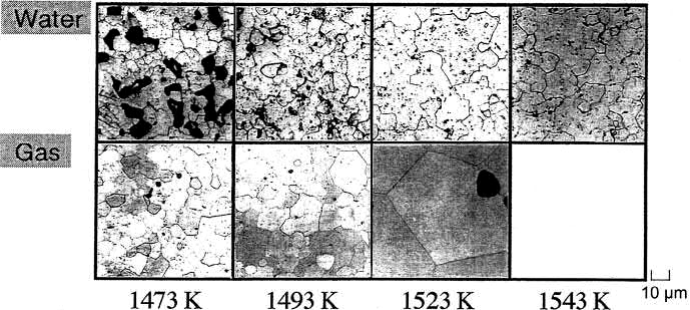
Fig. 21.25 Microstructures of MIM Sendust alloy compacts using gas- and water-atomized powders, sintered at various temperatures
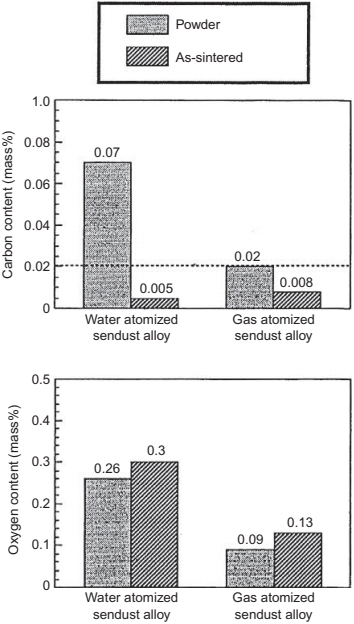
Fig. 21.26 Carbon and oxygen contents of the powders and sintered compacts
Table 21.4 Magnetic properties of the Sendust alloys produced by various processes
MIM | ||||
Gas | Water | PM | Wrought | |
Relative density (%) Maximum magnetic flux density, B10 (kG) Residual magnetic flux density, Br (kG) Coercive force, Hc (Oe) | 98 8.3 0.78 0.07 | 99 8.9 5.6 0.32 | 92 6.3 2.0 0.1 | 100 10.0 - 0.02 |
Table 21.5 Chemical composition of Fe-50Ni
Prealloyed powder | ||||||
Mean particle size: 14.2μm | ||||||
Ni | Si | C | 0 | S | Fe | |
Mass% | 50.1 | 0.93 | 0.012 | 0.055 | 0.005 | Bal. |
A gas-atomized powder was prepared as prealloyed powder, and the carbonyl Fe powder and atomized Ni powder were mixed in the ratio of 50:50 as mixed elemental powders. The composition of each powder is shown in Table 21.5. The binder consists of paraffin wax (69 mass%), polypropylene (20 mass%), carnauba wax (10 mass%), and stearic acid (1 mass%) as previously. Powders and binders were mixed in the ratio of 60:40 and kneaded at 418 K for 1.8 ks. Disc-type specimens (diameter: 30mm, height: 8.3mm) were prepared by injection-molding machine and solvent debinding was carried out to remove the wax component. Finally, thermal debinding and sintering were carried out continuously in a hydrogen atmosphere. After sintering, relative density and the amount of carbon and oxygen were measured. Ring-type specimens (outside diameter: 23mm, inside diameter: 13mm, thickness: 6.5mm) were also prepared for measurement of the magnetic properties, and annealed at 1373 K for 7.2 ks in a hydrogen atmosphere to remove the work strain.
The sintered density of prealloyed powder compact and mixed elemental powder compact is shown in Fig. 21.27. With the increase of sintering temperature, the sintered density also increases. For all sintering temperatures, the mixed elemental powder shows higher sintered density compared with the prealloyed powder. The optical microstructure of both compacts for each sintering temperature is shown in Fig. 21.28. In the case of the prealloyed powder compact sintered at 1473 K, a lot of connected pores are observed. However, the number of connected pores decreases with increase of sintering temperature, and at 1623 K, which shows high density, circular-like pores were observed. On the other hand, the mixed elemental powder compact shows fine circular pores at all sintering temperatures. The grain size of both powders is increased to the same degree by increase of sintering temperature. For the compacts sintered at 1623 K, the mixed elemental powder compact shows large grain size. Heterogeneous microstructure of the mixed elemental powder compact could be caused by the segregation of Ni and Fe; however, it was not observed by optical microscope.
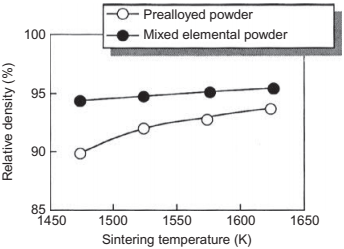
Fig. 21.27 Effect of sintering temperature on the sintered density of MIM Fe-50 mass%Ni compacts
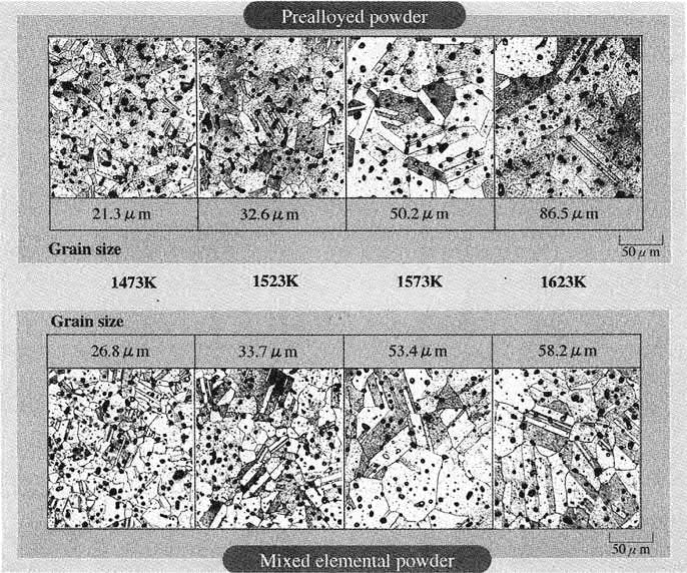
Fig. 21.28 Microstructures of MIM Fe-50 mass%Ni compacts sintered at various temperatures for 3.6 ks in hydrogen
The maximum permeability, coercive force and saturation flux density are generally estimated when discussing soft magnetic properties. For soft magnetic materials, high maximum permeability and low coercive force are desirable for demagnetization. Fig. 21.29 shows the results for the previously mentioned characteristics. Maximum permeability of both powder compacts increases with increase of sintering temperature. However, the mixed elemental powder shows a significantly lower value of maximum permeability. Also, in terms of coercive force, it might be interpreted that the prealloyed powder compact shows better magnetic properties. On the other hand, the saturation flux density of both powder compacts shows an approximately constant value. This proves that the mixed elemental powder compact exhibits good magnetic properties.
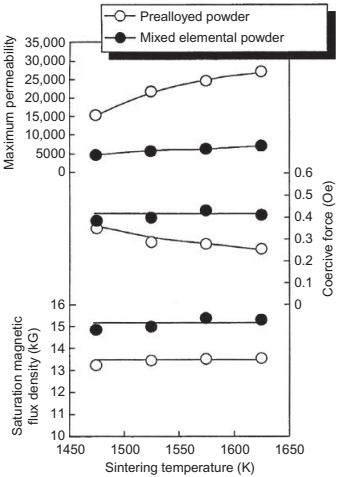
Fig. 21.29 Effect of sintering temperature on the magnetic properties of MIM Fe-50 mass%Ni compacts
Among magnetic properties, the maximum permeability and coercive force are known to be susceptible to grain size and impurities (especially interstitial elements such as C, O, P, and N). Therefore, the amount of carbon and oxygen remaining after sintering was analyzed and the results are shown in Fig. 21.30. The carbon amount of both powders was suppressed at low levels; however, oxygen amount was at a significantly higher level in the mixed elemental powder compacts when compared to the prealloyed powder compacts. Therefore, to improve the magnetic properties of mixed elemental powder compacts, a further investigation was carried out on the following two points.
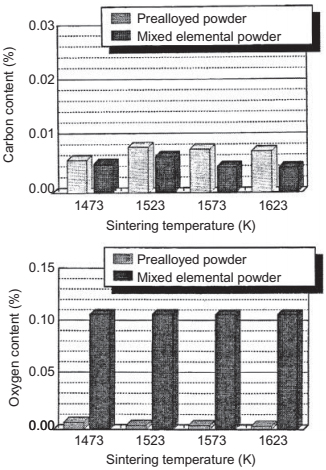
Fig. 21.30 Effect of sintering temperature on the carbon and oxygen contents of MIM Fe-50 mass %Ni compacts
As mentioned before, the heterogeneous microstructure was not observed by optical microscope, but the diffusion degree (or concentration distribution) of each element was specifically investigated by electron probe microanalyzer (EPMA). The results are shown in Fig. 21.31. For the mixed elemental powder compact heated at 873 K, each powder particle (Fe and Ni) was observed as it is; this means that diffusion of Fe and Ni does not happen. At 1273 K, a heterogeneous microstructure was found because the diffusion of elements occurred over a partial area. However, at 1623 K, the mixed elemental powder compact shows the particles' uniform concentration distribution and homogeneous microstructure, and then the degradation of magnetic properties was not seen.
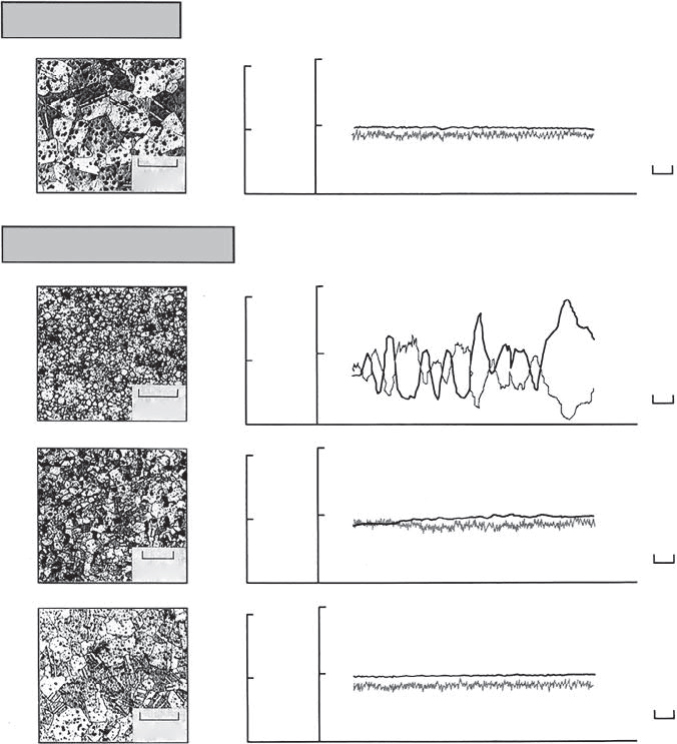
Fig. 21.31 EPMA line analysis of MIM Fe-50 mass%Ni compacts sintered under various conditions
Subsequently, an investigation on the effects of oxygen decrement was carried out. First, the effect of heating rate of thermal debinding on decreasing oxygen was examined. The heating pattern shown in Fig. 21.32 (heating rate 4 K/min until 874 K, holding for 60s, and then heating up at 10 K/min to sintering temperature) was applied. To promote the deoxidation in a hydrogen atmosphere, the compact was kept at 773 K and 873 K for 3.6 ks; however, a decrease of oxygen amount was not confirmed, as shown in Fig. 21.32. The compacts were also heated slowly up at 2 K/min to 873 K; however, the amount of oxygen was not changed. From the previous results, it is clear that heating rate up to sintering temperature does not cause a decrease in oxygen amount.
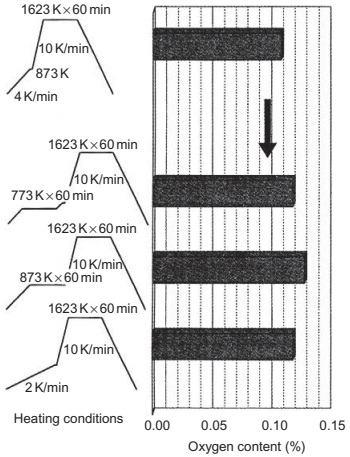
Fig. 21.32 Effect of heating condition on the oxygen content of MIM Fe-50 mass%Ni compacts
Next, an attempt was made to promote deoxidation by using high carbon carbonyl Fe powder, including 0.8 mass% carbon, as in Table 21.6. The results are shown in Fig. 21.33. The amount of oxygen is decreased from 0.14% to 0.01%, and it was also confirmed that the amount of carbon is not changed when compared to the low-carbon carbonyl Fe powder. The magnetic properties of all compacts are shown in Fig. 21.34. Sintering was performed at 1623 K for 3.6 ks because this was the condition to obtain favorable magnetic properties of the mixed elemental powder compact. Higher maximum permeability and low coercive force were obtained by high-carbon carbonyl Fe powder; therefore, the magnetic properties could be improved by decreasing the oxygen amount of the mixed elemental powder compact. As compared to the prealloyed powder compact, a favorable coercive force was also obtained. However, the maximum permeability was not improved, thus the reason for this low maximum permeability was investigated.
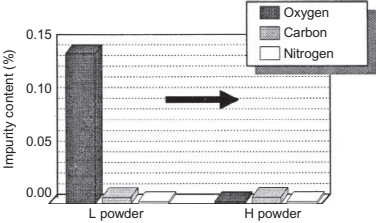
Fig. 21.33 Effect of powder type on the impurity contents of MIM Fe-50 mass%Ni compacts
Table 21.6 Chemical composition of carbonyl Fe powder with high carbon
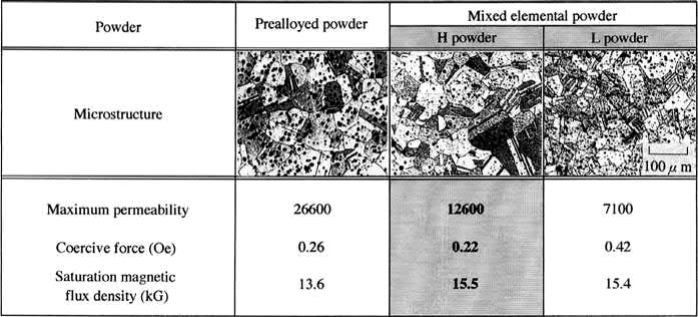
Fig. 21.34 Microstructures and magnetic properties of MIM Fe-50 mass%Ni compacts using various powders
The difference between the powders is the grain size, which is larger about 30 for mixed elemental powder, and maximum permeability is not seen to be greatly different for the small difference in grain size. It has been reported that the order lattice is formed by cooling rate in the Fe-Ni system and that the permeability decreases (Konuma, 1996), thus an X-ray diffraction test was conducted. The formation of FeNi3 was confirmed in both powder compacts, because the quantification of FeNi3 was difficult. Thus, a higher cooling rate after annealing was attempted in order to suppress the formation of FeNi3, and the effect on magnetic properties was investigated. The results are shown in Fig. 21.35. The magnetic properties of the prealloyed powder compact were not much affected by cooling rate. On the other hand, the magnetic properties of the mixed elemental powder compact were significantly improved by quenching. More precisely, in the case of low cooling rate after annealing, many FeNi3 phases are formed in the mixed elemental powder compact and the maximum permeability is decreased. The reason is not clear and this should be investigated specifically. Finally, supposing the heat treatment condition is optimized, the magnetic properties of the mixed elemental powder compact also could be improved as compared to those of the prealloyed powder compact.
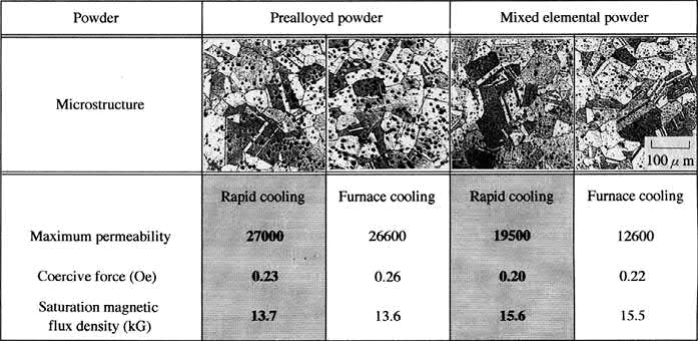
Fig. 21.35 Effect of rapid cooling after annealing on the microstructures and magnetic properties of MIM Fe-50 mass%Ni compacts
Fe-6.5Si: MIM compacts from three types of prealloyed Fe-6.5Si powders with different oxygen contents were produced, and the sintered properties and magnetic properties were investigated. The relative density of low-oxygen compacts was higher than the others; however, the grain growth was remarkably higher. The compacts using low-oxygen powder also show high purity after sintering. Lower-oxygen compacts show higher maximum permeability and coercive force; however, remarkable grain growth occurred and increased the iron loss at higher frequencies. Both high density and control of grain growth are necessary to obtain the best soft magnetic properties.
Fe-9.5Si-5.5Al: the properties and microstructures of injection-molded Sendust alloy compacts were strongly dependent on the type of powder and the processing parameters. In particular, the grain size and retained oxides are major factors which affect the magnetic properties. A continuous process, combining the debinding and sintering steps, offered 98% of theoretical density for both the gas-atomized and water-atomized powder compacts. However, the water-atomized compacts showed fine grain size and a large amount of retained oxides, resulting in poor magnetic properties. On the other hand, the gas-atomized powder compacts showed coarse grain size and a reduction of oxides, even under the same sintering conditions, which offered excellent magnetic properties close to those of wrought materials.
Fe-50Ni: permalloys fabricated by MIM process using different raw powders were investigated for their magnetic properties. The prealloyed powder compact showed low relative density at about 94%, and it was possible to suppress the remaining carbon and oxygen amount at a low level. For the mixed elemental powder compact, high relative density of 96% was obtained, compared to the prealloyed powder compact, and the segregation of Fe and Ni was not observed. However, the oxygen amount was significantly increased and not such good magnetic properties were obtained. It was possible to suppress the oxygen amount after sintering in the mixed elemental powder compact by using carbonyl Fe powder including high carbon, because the carbon promotes deoxidation. However, no improvement in magnetic properties was seen. For the mixed elemental powder compact, the formation of the intermetallic compound FeNi3 was a problem, and the magnetic properties were improved by quenching after annealing; it is thought that the optimization of heat treatment condition is a very important factor.
Contact: Cindy Wang
Phone: +86 19916725892
Tel: 0512-55128901
Email: [email protected]
Add: No.6 Huxiang Road, Kunshan development Zone, JiangsuShanghai Branch: No. 398 Guiyang Rd, Yangpu District, Shanghai, China